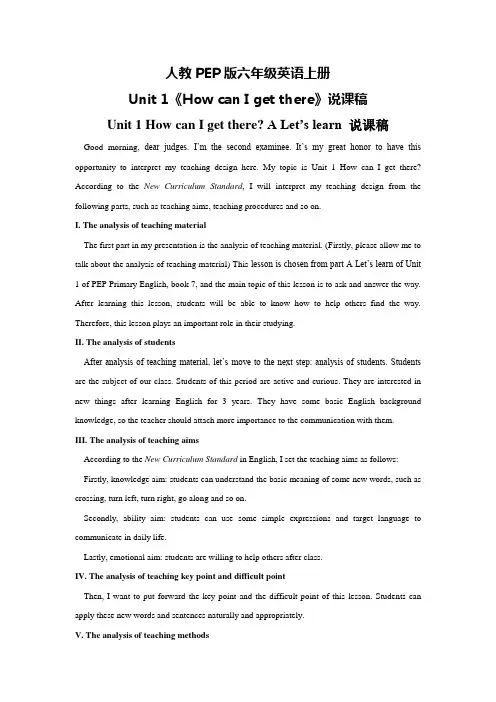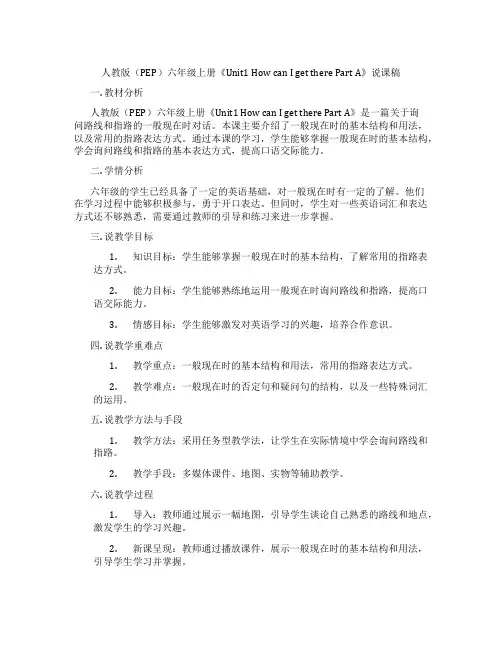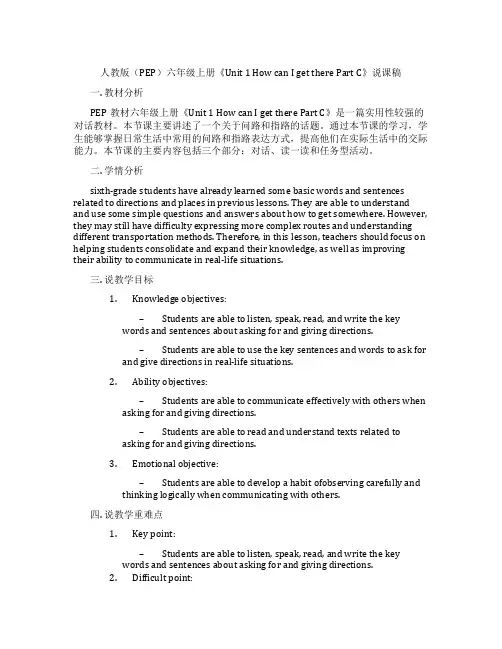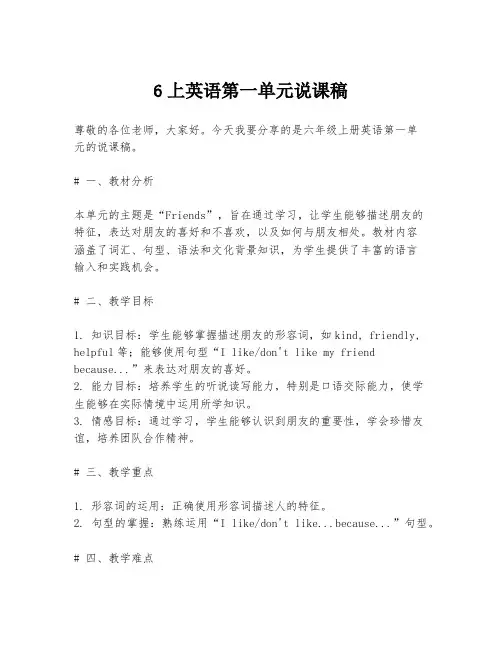小学英语六年级上册第一单元说课稿
- 格式:doc
- 大小:44.50 KB
- 文档页数:5

人教PEP版六年级英语上册第一单元教案Unit1 How can I get there?说课稿Part A(Lesson 1)说课稿各位评委,大家好。
今天我说课的内容是人教版英语六年级上册第一单元How can I get there? Part A的第一课时。
我今天的说课分为五个部分:教材分析,教法分析,学法分析,教学过程分析,板书设计。
一,教材分析本课的topic是描述地点与位置, 要求学生掌握一些地点名词,学会用方位介词描述它们的位置。
三维目标(一)知识目标1.掌握下列单词(1)有关地点的名词:bookstore, post office, hospital, cinema, science museum(2)有关位置的介词:in front of, behind, next to/near, across from,between…and…2.掌握下列句型A:What’s this/that?B:It’s a school.A: Where is the zoo?B: It’s next to the bookstore.(二)能力目标使学生熟练谈论地点与位置。
(三)情感目标通过灵活运用英语来提高学生的学习兴趣。
(四)教学重点难点重点:地点名词。
难点:方位介词。
二,教法分析本节课的对象是六年级的学生,天真、活泼,对新事物有很高的激情。
所以结合他们的这一特点,我采取了以下方法:1. 直观教学法。
通过用图片,视频和不同颜色字体展示教学新内容,加深学生对地点名词和方位介词的认知,激发学生的学习兴趣。
2. 课堂互动法。
通过师生交流,生生交流,实现师生互动。
鼓励学生大胆发言,营造平等交流气氛,让学生成为课堂学习的主体。
3. 情景教学法。
充分发挥教师的主导作用和学生的主体作用,为学生进行交际和表达创设更多生动活泼的语言环境,把学生吸引到活动中去,并激发他们主动参与学习的欲望三,学法分析创设情景,布置录像欣赏和互动游戏,激发学生的学习热情,培养他们的表达能力,发挥他们自己的主观能动性,把被动的学习变为主动学习。

人教PEP版六年级英语上册Unit 1《How can I get there》说课稿Unit 1 How can I get there? A Let’s learn说课稿Good morning, dear judges. I’m the second examinee. It’s my great honor to have this opportunity to interpret my teaching design here. My topic is Unit 1 How can I get there? According to the New Curriculum Standard, I will interpret my teaching design from the following parts, such as teaching aims, teaching procedures and so on.I. The analysis of teaching materialThe first part in my presentation is the analysis of teaching material. (Firstly, please allow me to talk about the analysis of teaching material) This lesson is chosen from part A Let’s learn of Unit 1 of PEP Primary English, book 7, and the main topic of this lesson is to ask and answer the way. After learning this lesson, students will be able to know how to help others find the way. Therefore, this lesson plays an important role in their studying.II. The analysis of studentsAfter analysis of teaching material, let’s move to the next step: analysis of students. Students are the subject of our class. Students of this period are active and curious. They are interested in new things after learning English for 3 years. They have some basic English background knowledge, so the teacher should attach more importance to the communication with them.III. The analysis of teaching aimsAccording to the New Curriculum Standard in English, I set the teaching aims as follows: Firstly, knowledge aim: students can understand the basic meaning of some new words, such as crossing, turn left, turn right, go along and so on.Secondly, ability aim: students can use some simple expressions and target language to communicate in daily life.Lastly, emotional aim: students are willing to help others after class.IV. The analysis of teaching key point and difficult pointThen, I want to put forward the key point and the difficult point of this lesson. Students can apply these new words and sentences naturally and appropriately.V. The analysis of teaching methodsNow I want to talk about the teaching methods. Communicative Approach, Tasked-based Teaching Method and TPR Teaching Method will be adopted in this lesson to active my students. VI. The analysis of teaching aidsTo help students learn better. I will mainly use pictures and tape recorder as teaching aids. VII. The analysis of teaching procedureNext, let’s focus on the most important part of this lesson, the analysis of teaching procedures. It consists of the following steps: warming-up, pre-listening, while-listening, post-listening, summary and homework.Now, let’s go to the first step,warming-up. In this step, I will divide students into groups Monkey 1 and Monkey 2, the one who gets banana first is the winner. Then I will sing a song named penguin’s Game. After listening, students should tell me what they have heard in this song. Then I will tell students this song is about directions. This song is closed related to the topic of this lesson. Besides, It’s very interesting for students. They would be very glad to pay attention to this lesson.Then, let’s come to the second step, pre-listening. I will draw a map and some buildings on the blackboard. Imagine I’m a foreigner and get lost. Let students help me find my way. Then I will show them some new words such as, turn left, turn right, crossing and go straight through many actions. And a word game will be arranged. It’s a bomb game. If I say a word, students should read after me quickly. But when I read the boom word, students should be quiet. Through this activity, students will be attracted and know how to read and use the new words.Now let’s talk about next period, while-listening. There are 3 activities in this step. The first activity is extensive listening. I’ll ask students to listen to the tape, then find out the main idea of this conversation. The second activity is intensive listening. I will ask students to listen to the tape once again. And try to find the answer, “Where is the Italian restaurant?” The third activity is to read. Students should read after the tape and pay attention to their pronunciation. Through this section, students could develop the ability of grasp detailed information and cooperation spirit. They will join more class activities actively.Next step is post-listening. Some students will be asked to come the front of the class, and do some actions. The other students will guess the meaning of these new words. Then I will pick one place in the map like bookstore. Ask students “Where’ the bookstore?” Students will tell me theway in their own words according to the map. Role play is very attractive for students. Students would like to take part in it very actively. By this, students can improve their speaking skills and understand how to use these sentences to communicate with others.Now, let’s move on to the summary and homework. At the end of the class, I’ll make a summary together with students. The purpose of this step is to help students recall what we have learned today. And deepen their impression of the key words and sentences. The homework is to be a guide. Tell their friends the way to the house with the target language. Next class, I’ll invite some students to share it. It can develop their independent learning ability and provide more opportunities to practice after class. At last, I will attract students attention and tell students the winner of this class.VIII. The analysis of blackboard designThe last part is my blackboard design. These are the new words and phrases. These are key sentences. It’s very clear and simple for students. And the pictures can attract students attention. That’s all for my presentation. Thank you for your listening.。

人教PEP版英语六年级上册Unit 1《How can I get there》说课稿一. 教材分析《人教PEP版英语六年级上册Unit 1 How can I get there》是一篇关于日常交际用语的课文。
本节课主要介绍了如何询问和描述路线和方向。
通过本节课的学习,学生能够掌握日常生活中常用的交通方式,如“walk”, “bus”, “bike”等,并能够运用所学知识询问和描述到达某地的路线。
教材内容贴近学生生活实际,有利于激发学生学习兴趣,提高学生英语应用能力。
二. 学情分析六年级的学生已经具备了一定的英语基础,对日常交际用语有一定的了解。
但是,学生在实际运用英语进行交际时,还存在一定的困难。
因此,在教学过程中,教师需要关注学生的个体差异,充分调动学生的积极性,引导他们积极参与课堂活动,提高他们的英语交际能力。
三. 说教学目标1.知识目标:学生能够掌握日常生活中常用的交通方式,如“walk”,“bus”, “bike”等,并能够运用所学知识询问和描述到达某地的路线。
2.能力目标:学生能够听懂、说出生日的日常交际用语,提高英语交际能力。
3.情感目标:通过本节课的学习,学生能够增强自信心,更加热爱英语学习。
四. 说教学重难点1.重点:学生能够掌握日常生活中常用的交通方式,并能够运用所学知识询问和描述到达某地的路线。
2.难点:学生能够在实际情景中灵活运用所学知识进行交际。
五. 说教学方法与手段1.情景教学法:通过设置真实的生活场景,让学生在实际情景中学习、运用英语。
2.交际法:引导学生积极参与课堂交际活动,提高他们的英语交际能力。
3.任务型教学法:通过完成具体任务,让学生在实践中掌握英语知识。
4.多媒体教学手段:运用多媒体课件、视频等资源,丰富教学内容,提高学生的学习兴趣。
六. 说教学过程1.热身(5分钟):教师与学生进行简单的英语对话,营造轻松愉快的课堂氛围。
2.引入(10分钟):教师通过展示一幅地图,引导学生谈论自己熟悉的路线和方向,为新课的学习做好铺垫。

六年级上册英语说课稿 - Unit 1 Li Ming Goes to Canada
Lesson 4 Making Dinner
一、教学目标
1.知识目标
1.能听说能力:能听懂、会说单词:potatoes, carrots, onions, tomatoes;会正确朗读句子:What are you cooking? I’m cooking soup/ spaghetti.
2.能语法结构:掌握“be +动词 -ing”的使用。
3.了解西餐文化。
2.能力目标
1.提高学生听说能力,培养学生口头表达能力。
2.发展学生对外语文化的认知能力,了解不同国家饮食文化。
3.情感态度价值目标
1.培养学生烹饪意识,增强自我管理、独立生活的能力。
2.培养学生对文化的尊重和了解,增强文化自信心。
二、教学重难点
1.教学重点
1.理解和运用本课所学汉英词汇和句式。
2.了解西餐文化。
2.教学难点
1.能够准确朗读句子,并且能够用正确的语音、语调表达。
2.能够理解并自如地应用“be +动词 -ing”的使用,准确表达正在做的事情。
三、教学过程
1.导入(4分钟)
1.英语单词的拼写练习,如potatoes,spaghetti等。
2.谈论食物有哪些种类,如蔬菜、水果、肉类等。
2.新课讲解及练习(30分钟)
1.让学生用英语自我介绍并介绍自己喜欢的食物。
2.向学生展示菜单并让学生试图用英语标示出上面的食物。
3.引导学生观看视频,理解并模仿语音、语调,运用句子。

新人教版(PEP)六年级上册英语《Unit1 How can I get there (2)》说课稿一. 教材分析新人教版(PEP)六年级上册英语《Unit1 How can I get there (2)》主要包括两部分内容:Part A和Part B。
本节课的主要内容是让学生掌握如何询问和描述路线和地点。
通过学习本节课,学生将能够运用所学的语言知识进行实际交流,提高他们的语言运用能力。
二. 学情分析六年级的学生已经具备了一定的英语基础,对于日常生活中的基本词汇和简单句型已经有了一定的了解。
但是,对于如何询问和描述路线和地点的句子结构和表达方式还不够熟悉。
因此,在教学过程中,教师需要注重引导学生运用已有的知识储备,进行新的语言实践。
三. 说教学目标1.知识目标:学生能够掌握并正确运用询问和描述路线和地点的句型和词汇。
2.能力目标:学生能够在实际情景中运用所学知识进行交流,提高他们的语言运用能力。
3.情感目标:通过学习本节课,学生能够增强对英语学习的兴趣,培养合作意识和团队精神。
四. 说教学重难点1.重点:学生能够掌握并正确运用询问和描述路线和地点的句型和词汇。
2.难点:学生能够在实际情景中灵活运用所学知识进行交流。
五. 说教学方法与手段1.采用任务型教学法,通过设定不同的任务,引导学生参与课堂活动,提高他们的语言运用能力。
2.运用多媒体教学手段,如图片、视频等,为学生提供直观的学习材料,增强他们的学习兴趣。
3.采用分组合作学习的方式,培养学生的团队协作能力和沟通能力。
六. 说教学过程1.热身(5分钟):通过播放一首与交通工具有关的英语歌曲,让学生放松心情,同时激活他们的相关词汇和句型。
2.引入(10分钟):教师向学生展示一幅学校附近的地图,引导学生谈论自己所知道的路线和地点,为新课的学习做好铺垫。
3.呈现(15分钟):教师通过展示一幅学校的平面图,向学生介绍如何询问和描述路线和地点的句型和词汇。

六年级上册英语说课稿《Unit1 How can I get there B》人教(PEP) (5)一. 教材分析《Unit1 How can I get there B》是人教版PEP六年级上册英语教材的第一单元,本节课主要讲述了如何描述路线和地点。
通过本节课的学习,学生能够掌握相关词汇如“turn left/right”,“go strght”,“cross the road”等,并且能够用英语询问和描述如何到达某个地方。
教材内容贴近学生生活,有助于激发学生的学习兴趣,同时培养他们的语言运用能力。
二. 学情分析六年级的学生已经具备了一定的英语基础,对于日常生活中的基本词汇和简单句型已经有了一定的了解。
但是,对于描述路线和地点的词汇和句型可能还比较陌生,因此需要在教学中进行重点引导和练习。
此外,学生们的思维方式和学习习惯也有所不同,因此在教学过程中需要因材施教,充分调动学生的积极性。
三. 说教学目标1.知识目标:学生能够掌握描述路线和地点的词汇和句型,如“turnleft/r ight”,“go strght”,“cross the road”等,并能够用英语询问和描述如何到达某个地方。
2.能力目标:学生能够通过听力、口语、阅读和写作等多种方式,运用所学词汇和句型描述路线和地点。
3.情感目标:通过本节课的学习,学生能够增强学习英语的兴趣,提高自信心,培养合作精神。
四. 说教学重难点1.重点:描述路线和地点的词汇和句型。
2.难点:如何运用所学词汇和句型准确地询问和描述如何到达某个地方。
五. 说教学方法与手段本节课采用任务型教学法,通过各种任务活动,让学生在实际操作中学习和运用描述路线和地点的词汇和句型。
同时,运用多媒体教学手段,如图片、视频、地图等,帮助学生更好地理解和记忆所学内容。
六. 说教学过程1.热身(5分钟):通过简单的英语问候和讨论,引导学生进入英语学习状态。
2.呈现(10分钟):通过展示图片、视频或地图,引入本节课的主题,引导学生学习和掌握描述路线和地点的词汇和句型。

人教版小学英语六年级上册《Unit 1 How can I get there 》单元说课稿(6课时)说课稿一. 教材分析《Unit 1 How can I get there》是人教版小学英语六年级上册的第一个单元,本单元主要围绕“如何到达某个地方”的主题展开。
通过本单元的学习,学生能够掌握有关交通工具和方向的词汇,如bus, trn, car, left, right, strght等,并能够运用这些词汇描述自己的路线和询问他人的路线。
同时,学生还能够学会使用can引导的一般疑问句,询问他人能否做某事。
本单元的内容与学生的生活实际紧密相连,有利于激发学生的学习兴趣和积极性。
二. 学情分析六年级的学生已经具备了一定的英语基础,能够听懂并运用简单的英语进行交流。
然而,部分学生在英语学习上存在一定的困难,如词汇量不足、语法知识不扎实等。
此外,学生在学习过程中容易受到母语的干扰,导致英语表达不准确。
针对这些情况,教师在教学过程中应注重激发学生的学习兴趣,调动他们的积极性,同时加强对学生英语基础知识的巩固和指导。
三. 说教学目标1.知识目标:学生能够掌握有关交通工具和方向的词汇,如bus, trn,car, left, right, strght等;能够运用这些词汇描述自己的路线和询问他人的路线;学会使用can引导的一般疑问句,询问他人能否做某事。
2.能力目标:学生能够在图片或情景的帮助下,正确使用本单元所学词汇和句型进行简单的交流,达到“能交流”的目标。
3.情感目标:培养学生热爱生活、积极乐观的人生态度,使他们更加关注身边的事物,学会用英语描述生活中的场景。
四. 说教学重难点1.重点:学生能够掌握有关交通工具和方向的词汇,如bus, trn, car,left, right, strght等;能够运用这些词汇描述自己的路线和询问他人的路线;学会使用can引导的一般疑问句,询问他人能否做某事。
2.难点:学生能够在实际情景中灵活运用本单元所学词汇和句型进行交流,同时注意语音、语调的准确表达。

人教版(PEP)六年级上册《Unit1 How can I get there Part A》说课稿一. 教材分析人教版(PEP)六年级上册《Unit1 How can I get there Part A》是一篇关于询问路线和指路的一般现在时对话。
本课主要介绍了一般现在时的基本结构和用法,以及常用的指路表达方式。
通过本课的学习,学生能够掌握一般现在时的基本结构,学会询问路线和指路的基本表达方式,提高口语交际能力。
二. 学情分析六年级的学生已经具备了一定的英语基础,对一般现在时有一定的了解。
他们在学习过程中能够积极参与,勇于开口表达。
但同时,学生对一些英语词汇和表达方式还不够熟悉,需要通过教师的引导和练习来进一步掌握。
三. 说教学目标1.知识目标:学生能够掌握一般现在时的基本结构,了解常用的指路表达方式。
2.能力目标:学生能够熟练地运用一般现在时询问路线和指路,提高口语交际能力。
3.情感目标:学生能够激发对英语学习的兴趣,培养合作意识。
四. 说教学重难点1.教学重点:一般现在时的基本结构和用法,常用的指路表达方式。
2.教学难点:一般现在时的否定句和疑问句的结构,以及一些特殊词汇的运用。
五. 说教学方法与手段1.教学方法:采用任务型教学法,让学生在实际情境中学会询问路线和指路。
2.教学手段:多媒体课件、地图、实物等辅助教学。
六. 说教学过程1.导入:教师通过展示一幅地图,引导学生谈论自己熟悉的路线和地点,激发学生的学习兴趣。
2.新课呈现:教师通过播放课件,展示一般现在时的基本结构和用法,引导学生学习并掌握。
3.对话学习:教师引导学生跟读对话,理解对话内容,并进行角色扮演,提高口语表达能力。
4.实践环节:教师布置任务,让学生分组讨论并绘制一幅简单的路线图,培养学生的实际应用能力。
5.总结提升:教师带领学生回顾本节课所学内容,进行小结。
6.作业布置:学生回家后,向家人介绍自己学校的路线,巩固所学知识。

人教版(PEP)六年级上册《Unit 1 How can I get there Part C》说课稿一. 教材分析PEP教材六年级上册《Unit 1 How can I get there Part C》是一篇实用性较强的对话教材。
本节课主要讲述了一个关于问路和指路的话题。
通过本节课的学习,学生能够掌握日常生活中常用的问路和指路表达方式,提高他们在实际生活中的交际能力。
本节课的主要内容包括三个部分:对话、读一读和任务型活动。
二. 学情分析sixth-grade students have already learned some basic words and sentences related to directions and places in previous lessons. They are able to understand and use some simple questions and answers about how to get somewhere. However,they may still have difficulty expressing more complex routes and understanding different transportation methods. Therefore, in this lesson, teachers should focus on helping students consolidate and expand their knowledge, as well as improving their ability to communicate in real-life situations.三. 说教学目标1.Knowledge objectives:–Students are able to listen, speak, read, and write the key words and sentences about asking for and giving directions.–Students are able to use the key sentences and words to ask for and give directions in real-life situations.2.Ability objectives:–Students are able to communicate effectively with others when asking for and giving directions.–Students are able to read and understand texts related to asking for and giving directions.3.Emotional objective:–Students are able to develop a habit ofobserving carefully and thinking logically when communicating with others.四. 说教学重难点1.Key point:–Students are able to listen, speak, read, and write the key words and sentences about asking for and giving directions.2.Difficult point:–How to help students use the key sentences and words to ask for and give directions in real-life situations.五. 说教学方法与手段1.Teaching methods:–Task-based language teaching: Students learn by doing, which helps them to consolidate their knowledge and skills through practicalactivities.-交际法: 通过模拟真实情境,让学生在实际交流中掌握语言知识。

人教PEP六年级上册英语《Unit 1 Part B Let’s try-Let’s talk 》说课稿一. 教材分析人教PEP六年级上册英语《Unit 1 Part B Let’s try-Let’s talk》是人教版小学英语教材PEP六年级上册的第一单元Part B部分,本节课的主要内容是围绕“询问时间”和“回答时间”的交际情景展开。
通过本节课的学习,学生能够掌握一般现在时的疑问句和回答句的构成及运用,能够运用所学知识进行实际生活中的时间交流。
二. 学情分析根据六年级学生的认知特点,他们对英语有了一定的了解和掌握,具备一定的听说读写能力。
但是,对于一般现在时的疑问句和回答句的运用,部分学生可能还存在一定的困难。
因此,在教学过程中,需要关注学生的个体差异,针对性地进行教学设计和引导。
三. 说教学目标1.知识目标:学生能够掌握一般现在时的疑问句和回答句的构成及运用。
2.能力目标:学生能够运用所学知识进行实际生活中的时间交流。
3.情感目标:激发学生学习英语的兴趣,培养良好的学习习惯。
四. 说教学重难点1.教学重点:一般现在时的疑问句和回答句的构成及运用。
2.教学难点:一般现在时的疑问句和回答句在实际交流中的运用。
五. 说教学方法与手段1.情景教学法:通过创设生活中的时间场景,让学生在实际情境中学习和运用英语。
2.任务型教学法:设计具有实际意义的学习任务,让学生在完成任务的过程中运用所学知识。
3.互动式教学法:引导学生积极参与课堂互动,提高学生的口语表达能力和交际能力。
4.信息技术手段:利用多媒体课件、图片等教学资源,增加课堂的趣味性和生动性。
六. 说教学过程1.导入:通过与学生生活相关的时间话题,引起学生对时间的关注,激发学习兴趣。
2.呈现:展示一般现在时的疑问句和回答句的图片,引导学生观察和理解。
3.操练:让学生分组进行角色扮演,模拟实际生活中的时间交流情景,巩固所学知识。
4.实践:设计具有实际意义的时间任务,让学生在完成任务的过程中运用所学知识。

6上英语第一单元说课稿尊敬的各位老师,大家好。
今天我要分享的是六年级上册英语第一单元的说课稿。
# 一、教材分析本单元的主题是“Friends”,旨在通过学习,让学生能够描述朋友的特征,表达对朋友的喜好和不喜欢,以及如何与朋友相处。
教材内容涵盖了词汇、句型、语法和文化背景知识,为学生提供了丰富的语言输入和实践机会。
# 二、教学目标1. 知识目标:学生能够掌握描述朋友的形容词,如kind, friendly, helpful等;能够使用句型“I like/don't like my friend because...”来表达对朋友的喜好。
2. 能力目标:培养学生的听说读写能力,特别是口语交际能力,使学生能够在实际情境中运用所学知识。
3. 情感目标:通过学习,学生能够认识到朋友的重要性,学会珍惜友谊,培养团队合作精神。
# 三、教学重点1. 形容词的运用:正确使用形容词描述人的特征。
2. 句型的掌握:熟练运用“I like/don't like...because...”句型。
# 四、教学难点1. 语法结构的准确运用:确保学生在使用句型时,能够正确表达自己的观点。
2. 情感态度的培养:引导学生理解友谊的价值,形成积极的社交态度。
# 五、教学方法1. 情景教学法:通过创设情景,让学生在模拟的社交环境中使用语言。
2. 合作学习法:鼓励学生小组合作,通过讨论和角色扮演来加深对语言的理解。
3. 任务型教学法:设计任务,让学生在完成任务的过程中学习语言。
# 六、教学过程1. 导入:通过展示不同人物的图片,引导学生讨论他们可能的性格特征,激发学生的兴趣。
2. 呈现:教授新词汇和句型,通过多媒体教学工具展示,确保学生能够正确发音和理解。
3. 练习:设计多种练习活动,如填空、对话练习、角色扮演等,让学生在实践中掌握知识。
4. 应用:让学生描述自己的一个朋友,使用所学词汇和句型。
5. 总结:回顾本节课的重点内容,强调语言的准确运用和情感态度的重要性。
六年级英语上册(人教版pep)Unit 1 How can I get there全单元说课稿一. 教材分析本次说课的教材为人教版PEP小学六年级英语上册第一单元“How can I get there”。
本单元主要围绕着问路和指路的话题展开,让学生学会如何用英语询问路线和描述路线。
通过本单元的学习,学生能够进一步掌握英语中常用的表达方式,提高他们的语言运用能力。
二. 学情分析针对六年级学生的学习特点,他们在学习英语的过程中已经积累了一定的词汇量和基本语法知识,具备一定的听、说、读、写的能力。
但是,学生在实际运用英语进行交流时还存在着一定的困难,特别是在询问路线和描述路线方面。
因此,教师在教学过程中需要关注学生的实际需求,注重培养他们的语言运用能力。
三. 说教学目标1.知识目标:学生能够掌握本单元的重点词汇和句型,如“How can Iget there?”、“Go strght, then turn right.”等,并能够运用所学知识进行实际交流。
2.能力目标:通过本单元的学习,学生能够提高自己的听、说、读、写能力,特别是在询问路线和描述路线方面。
3.情感目标:培养学生热爱生活、乐于助人的品质,使他们能够在生活中主动与人交流,提高他们的社交能力。
四. 说教学重难点1.重点:本单元的重点是让学生掌握询问路线和描述路线的词汇和句型。
2.难点:学生需要学会如何将英语知识运用到实际生活中,提高他们的语言运用能力。
五. 说教学方法与手段1.教学方法:采用情境教学法、任务型教学法和交际法,让学生在真实的情境中学习英语,提高他们的语言运用能力。
2.教学手段:利用多媒体课件、地图、实物等教学资源,帮助学生更好地理解和运用所学知识。
六. 说教学过程1.导入:教师通过展示一幅地图,引导学生谈论自己熟悉的路线,为新课的学习营造一个轻松愉快的学习氛围。
2.新课呈现:教师通过播放课件,展示本节课的主要内容,引导学生学习询问路线和描述路线的词汇和句型。
六年级上册英语说课稿《Unit1 How can I get there C》人教(PEP)( 秋)一. 教材分析《Unit1 How can I get there C》是人教版PEP六年级上册英语教材的一部分。
本单元主要学习关于问路和指路的内容,通过本节课的学习,学生能够掌握基本的问路和指路表达方式,提高他们在实际生活中的交际能力。
教材内容丰富,包括听力、口语、阅读和写作等方面,有助于学生全面提高英语水平。
二. 学情分析六年级的学生已经具备了一定的英语基础,对于问路和指路的话题也有一定的生活经验。
但部分学生在发音和听力方面还存在困难,需要特别关注和辅导。
此外,学生在本节课需要掌握的词汇和句型较为复杂,需要通过多种教学手段帮助他们理解和运用。
三. 说教学目标1.知识目标:学生能够掌握表示问路和指路的词汇和句型,如“Howcan I get to…?”、“Go strght and turn right at the…”等。
2.能力目标:学生能够在实际情境中运用所学知识进行问路和指路,提高他们的交际能力。
3.情感目标:培养学生热爱生活,善于观察,乐于助人的品质。
四. 说教学重难点1.重点:学生能够掌握表示问路和指路的词汇和句型,并在实际情境中运用。
2.难点:学生能够正确发音,并在实际交流中灵活运用所学知识。
五. 说教学方法与手段1.交际法:通过模拟生活场景,让学生在实际交流中学会问路和指路。
2.情境教学法:创设各种生活情境,激发学生的学习兴趣和积极性。
3.游戏教学法:通过趣味游戏,让学生在轻松愉快的氛围中学习英语。
4.信息技术辅助教学:利用多媒体课件和网络资源,提高教学效果。
六. 说教学过程1.热身(5分钟):播放英语歌曲,让学生放松心情,复习相关词汇。
2.导入(10分钟):通过展示图片,引入本节课的主题,激发学生的兴趣。
3.教学新课(20分钟):讲解新词汇和句型,让学生进行听力练习和口语模仿。
六年级上册英语说课稿《Unit 1Part B Read and write 》人教(PEP)版一. 教材分析本次说课的教材为人教版PEP小学英语六年级上册第一单元B部分的读写内容。
这部分内容主要围绕“家庭成员”展开,通过描述家庭成员的外貌、爱好和职业,让学生进一步掌握一般现在时的表达方式。
教材以实际生活场景为背景,引导学生运用所学知识进行实际交流,培养学生的语言运用能力。
二. 学情分析六年级的学生已经具备了一定的英语基础,对于一般现在时的表达方式有一定的了解。
但学生在实际运用中,对于家庭成员的描述和表达仍有一定的困难。
因此,在教学过程中,需要关注学生的个体差异,引导他们正确运用所学知识进行交流。
三. 说教学目标1.知识目标:学生能够听懂、会说、会读本节课的核心单词和句型,如family members, father, mother等。
2.能力目标:学生能够运用一般现在时描述家庭成员的外貌、爱好和职业。
3.情感目标:通过学习,学生能够增进对家人的了解,培养对家庭的热爱。
四. 说教学重难点1.重点:学生能够掌握本节课的核心单词和句型,并能运用一般现在时描述家庭成员。
2.难点:学生能够正确运用一般现在时描述家庭成员的外貌、爱好和职业。
五. 说教学方法与手段1.教学方法:采用任务型教学法,通过设定各种任务,让学生在实际交流中运用所学知识。
2.教学手段:利用多媒体课件、图片、卡片等辅助教学,提高学生的学习兴趣和参与度。
六. 说教学过程1.热身(5分钟):通过歌曲《Hello》引导学生唱跳,营造轻松愉快的课堂氛围。
2.引入(10分钟):展示家庭成员的图片,引导学生用中文描述家庭成员。
3.呈现(10分钟):通过课件展示一般现在时的句型,引导学生跟读并模仿。
4.实践(15分钟):学生分组进行角色扮演,运用一般现在时描述家庭成员。
5.巩固(10分钟):学生完成课本P17的练习题,检测学习效果。
6.拓展(5分钟):引导学生讨论家庭成员的兴趣爱好,培养学生的发散思维。
人教版(共PEP)六年级上册英语《Unit 1 How can I get there?》说课稿一. 教材分析《PEP》六年级上册英语《Unit 1 How can I get there?》是本套教材的第一个单元,主要围绕着“如何到达某个地方”的主题展开。
本节课主要介绍了常用的交通方式,如:by bus, by trn, by bike等,并学习了如何询问和描述到达某个地方的路线。
通过本节课的学习,学生能够掌握相关词汇和句型,并能够运用所学知识进行实际交流。
二. 学情分析六年级的学生已经具备了一定的英语基础,对于基本的日常交流和简单句型的构建已经不再陌生。
但是,对于复杂的路线描述和交通方式的选择仍然存在一定的困难。
因此,在教学过程中,教师需要关注学生的个体差异,对于不同程度的学生给予不同的指导和帮助,以确保每个学生都能跟上教学进度。
三. 说教学目标1.知识目标:学生能够掌握表示交通方式的词汇,如:bus, trn, bike等,以及询问和描述路线的句型,如:How can I get there? 和I can get there by…2.能力目标:学生能够用英语询问和描述到达某个地方的路线,并进行简单的交流。
3.情感目标:培养学生热爱生活,关注交通出行的意识。
四. 说教学重难点1.重点:掌握表示交通方式的词汇和询问描述路线的句型。
2.难点:能够准确地询问和描述复杂的路线。
五. 说教学方法与手段1.任务型教学法:通过设定各种真实的任务,让学生在完成任务的过程中运用所学知识,提高学生的实际运用能力。
2.情境教学法:创设各种真实的交通情境,让学生在情境中感知和运用所学知识。
3.合作学习法:引导学生进行小组合作,培养学生的团队协作能力和沟通能力。
六. 说教学过程1.导入:通过展示各种交通工具的图片,引导学生谈论交通工具,为新课的学习做好铺垫。
2.呈现:通过动画或故事的方式,展示本节课的主要内容,让学生在情境中感知和理解所学知识。
六年级上册英语说课稿《Unit1 How can I get there B》人教(PEP)( 秋)一. 教材分析本次说课的教材为人教版(PEP)六年级上册英语教材第一单元B部分,主题是“How can I get there”。
本节课的内容主要是让学生掌握常用的问路和指路的表达方式,以及如何根据地图和指示牌来找到目的地。
教材内容贴近学生的生活实际,有利于激发学生的学习兴趣,培养他们的实际应用能力。
二. 学情分析六年级的学生已经掌握了基本的英语语法和词汇,具备一定的听说读写能力。
他们在日常生活中也经常会遇到问路和指路的情况,对于本节课的内容有一定的认知基础。
但是,学生在实际运用英语进行问路和指路时,可能会存在一定的困难,需要通过课堂学习和实践来提高。
三. 说教学目标1.知识目标:学生能够掌握常用的问路和指路的表达方式,如“Howcan I get to …?”和“Turn left/right at …”,并能够根据地图和指示牌找到目的地。
2.能力目标:学生能够在日常生活中用英语进行问路和指路,提高他们的实际应用能力。
3.情感目标:学生能够积极参与课堂活动,增强自信心,培养合作意识。
四. 说教学重难点1.重点:学生能够掌握常用的问路和指路的表达方式,并能够根据地图和指示牌找到目的地。
2.难点:学生能够在实际情境中灵活运用所学知识,进行有效的问路和指路。
五. 说教学方法与手段本节课采用任务型教学法,通过设置各种真实情境,让学生在实践中学习和运用英语。
同时,运用多媒体教学手段,如课件、地图和指示牌等,辅助学生理解和记忆所学内容。
六. 说教学过程1.热身(5分钟):通过播放一首关于问路和指路的英文歌曲,激发学生的学习兴趣,并复习已学的相关词汇和表达方式。
2.导入(10分钟):教师出示一张地图,引导学生讨论如何根据地图找到某个地点,引出本节课的主题。
3.呈现(10分钟):教师通过课件展示本节课的主要内容,包括问路和指路的表达方式,以及如何根据地图和指示牌找到目的地。
人教版(PEP)六年级上册《Unit1 How can I get there Part C》说课稿一. 教材分析《Unit1 How can I get there Part C》是人教版(PEP)六年级上册英语教科书的一部分。
本单元主要围绕“如何到达某个地方”的主题展开,通过学习本单元,学生能够掌握询问和描述路线的交际用语。
Part C部分包含一个听力活动、两个对话和一个任务型活动。
内容涉及到人物角色间的对话,询问和描述具体路线。
二. 学情分析六年级的学生已经具备了一定的英语基础,能够听懂并运用简单的英语进行日常交流。
但是,对于描述复杂路线的英语表达,他们可能还比较陌生。
因此,在教学过程中,需要关注学生的个体差异,针对不同水平的学生给予适当的指导。
三. 说教学目标1.知识目标:学生能够听懂、会说、会读本课的生词和重点句子,掌握询问和描述路线的交际用语。
2.能力目标:学生能够运用所学的交际用语,询问并描述熟悉的地点和路线。
3.情感目标:通过小组合作完成任务,培养学生的团队协作精神,提高学生学习英语的兴趣。
四. 说教学重难点1.重点:学生能够听懂、会说、会读本课的生词和重点句子,掌握询问和描述路线的交际用语。
2.难点:学生能够运用所学的交际用语,描述较复杂的路线。
五. 说教学方法与手段1.交际法:通过模拟真实场景,让学生在实际交流中学会运用所学知识。
2.任务型教学法:通过完成具体任务,激发学生的学习兴趣,培养学生的实践能力。
3.信息技术辅助教学:利用多媒体课件、网络资源等,丰富教学手段,提高教学效果。
六. 说教学过程1.热身(5分钟):通过播放一首与出行相关的英语歌曲,让学生放松身心,营造轻松的学习氛围。
2.导入(10分钟):教师展示一张地图,引导学生谈论自己熟悉的地点和路线,为新课学习做好铺垫。
3.呈现(15分钟):教师播放听力材料,学生听后回答问题。
通过听力活动,让学生初步感知本课的主题。
4.操练(20分钟):学生分角色朗读对话,模仿语音语调。
PEP小学英语六年级上册Unit 1
一、说教材:
这节课的内容是PEP小学英语Book7Unit 1 How Do You Go There?Part B Let’s read(The Traffic Rules)。
本单元重点学习如何询问和回答人们日常出行的方式,这个话题与学生的日常生活紧密联系。
而本节课的内容是通过阅读短文培养学生的阅读能力,并了解部分国家交通文化的典型差异。
二、说教学目标:
1、知识目标:读懂短文,能认读same, every country, right side,
left side等新词组。
2、能力目标:培养学生获取信息和处理信息的能力;培养学生
良好的阅读习惯,学习并能运用阅读的方法。
3、情感目标:帮助学生建立自觉遵守交通规则的观念,了解不
同国家交通规则的异同。
三、说教学重难点
重点:帮助学生理解句型In China, drivers drive on the right side of the road. In the US, drivers drive on the right side, too. In England and Australia, however, drivers drive on the left side of the road.
难点:学生对文化差异的了解:在中国和美国等国家车辆靠右行驶,但在有些国家车辆靠左行驶,比如英国、澳大利亚等地。
四、说教法、学法:
(一)TPR活动法:用TPR活动法生动愉快地让学生适应上课,开始进入状态,同时是一个对以前的学习内容的复习,为下面的学习内容做铺垫,为学生展开新内容提供知识基础,也为课堂气氛增色不少。
(二)词不离句(语境):每一个陌生的单词或词组,都放在句子和短文中让学生去理解,培养学生在语境中猜词的能力。
(三)小组学习法:每四个人一组,在互动中互相启发产生思维的碰撞,同时注意保证每个学生都有机会参与学习、而培养学生和伙伴合作的意识和策略,提高人际交往能力。
学生也在独立与合作的交织中调控了自身的学习,变得自信、自强。
(四)练习法:最后设置一个读短文的练习,使学生将学习到的阅读方法得到实际的运用。
(五)借助多媒体辅助法、实物教学法来呈现材料,激发学生的学习兴趣和求知欲。
五、说教学过程:
本课采用五步教学法:
(一)Preparation准备活动。
由课前精彩一分钟引出教师的Chant(自我介绍,交通方式)
学生按交通方式分为四组,此时拍手连环Chant
Group bike: I go to school by bike. How do you go to school?
Group bus: I go to school by bus. How do you go to school?……
这一过程既是学生复习旧的语言知识,为下一步学习作好铺垫,也是通过TPR活动让学生把所有的注意力集中到课堂中来,为英语学习创造了一种良好的氛围。
(二)Pre-reading阅读前活动。
T仍用Chant节奏引出主题The traffic rules,板书课题并教授。
此过程为适应未学习过the traffic lights& rules的学生设计,既引入主题又渗透了新词组。
(三)In-reading 阅读中活动。
这一过程是为了培养学生获取信息和处理信息的能力,在完成任务的过程中逐步加深对阅读材料的理解,并培养其在语境中猜词的能力。
1、T以课件出示主题句Do you know the traffic rules? If you go by car, by bike or on foot, you must know the traffic rules.,领读渗透。
请学生默读短文第一部分并圈出生词。
处理生词。
采用同学说、一起猜和老师讲解三种方式。
最后一个生词预设为the traffic lights, 猜过词义后,引入三种交通信号灯及各自含义。
然后通过chant 和TPR活动巩固。
2、由交通信号灯引出第二段主题句“不一样的交通规则”The
traffic lights are the same in every country.But there are some differences in the traffic rules.
请学生仔细观察并找出两幅图的不同,由此教授新词组right side,on the right side of the road,on the left side of the road。
利用身体部位引导学生更多地练说,并用节奏来练习巩固。
请学生去文中寻找两幅图不同的原因,并圈出生词。
处理生词。
Ss 试回答两图不同的原因,T 帮助总结:Different country has different traffic rules.
引导学生再次阅读原文并完成任务活动,将文中几个国家的国旗分别贴到相应的交通规则下。
3、Let’ s know more.
出示课件,请学生了解不同方向行驶的更多知识。
(四)Post-reading阅读后活动。
1、听录音,跟读文章。
2、出示本文的两个概括性句子,根据教师的手势提示,分别
以个人、小组或集体的方式有感情地朗读。
3、根据板书集体复述课文主要内容。
4、根据阅读内容做判断练习。
这一过程是阅读后的扩展活动,要求学生全体参与,通过朗读、复述课文、做练习等活动加深对文章的理解。
(五)Progress 检测提高
1、阅读拓展性文章,粗体显示本课短文中曾出现过的生词。
2、引导学生思考,如果不遵守交规将有怎样后果?
3、请Ss根据之前所读所看,完成选词填空。
4、最后,通过问答来呈现Chant
We are good boys and girls.
We know the traffic rules.
We obey the traffic rules.
So, we are great!
这一过程是总结并运用本课所学内容、阅读方法,帮助学生建立并内化自觉遵守交通规则的观念。
六、说板书设计
根据the traffic rules的主题,这节课的板书我设计为以交通信号灯为框架,将一些主题词如stop, go, wait, on the left/ right side of the road等随教学步骤板书在框架内,并伴以几个国家的国旗。
这些内容是有多种作用的,有呈现,有操练,最后还是复述课文及总结的参照。
这就是我本堂课的全部内容和设计意图,希望各位老师给我多提宝贵的意见。
蒙山小学王春娟。